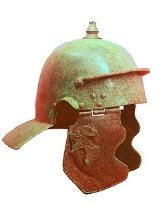
Cohors II Gallorum veterana equitata
Encyclopedia
Cohors secunda Gallorum veterana equitata ("2nd part-mounted veteran Cohort of Gauls") was a Roman auxiliary mixed infantry and cavalry regiment.
The regiment was probably constituted under Augustus
, the founder of the Roman empire
(r. 30 BC - AD 14). It was originally recruited from natives of Gallia Lugdunensis
(northern/central France).
The unit is first attested in the datable epigraphic record in AD 99 in Moesia Inferior (N. Bulgaria), from where it probably took part in the emperor Trajan
's Dacian Wars (101-6). It was briefly stationed in Mauretania Caesariensis
(N Algeria), where it is attested for 107. From at least 122 until its last known attestation of 244-9, it was in Britannia
, and thus saw the building of Hadrian's Wall
(122-32).
In Britannia, the regiment garrisoned, from 178 at the latest, the fort at Old Penrith
(Cumbria).
The reason for its unusual title of veterana, which only appears in an inscription dated 178, is unclear. It has been suggested that the title indicates some form of seniority over other units in the province.
The full names of 4 praefecti (commanders) of the regiment are known, all from the 2nd century. Three appear to have been northern Italians and one was from Nicomedia
in Bithynia
. In addition, we have the name of a single pedes (ranker foot-soldier), a Mysian from the province of Asia (99 AD). There is also attested (178) a certain Dacus, an eques (ranker cavalryman). The name, which simply means "the Dacian" was probably adopted by him because his native Dacian name was unpronounceable for Romans.
The regiment was probably constituted under Augustus
Augustus
Augustus ;23 September 63 BC – 19 August AD 14) is considered the first emperor of the Roman Empire, which he ruled alone from 27 BC until his death in 14 AD.The dates of his rule are contemporary dates; Augustus lived under two calendars, the Roman Republican until 45 BC, and the Julian...
, the founder of the Roman empire
Roman Empire
The Roman Empire was the post-Republican period of the ancient Roman civilization, characterised by an autocratic form of government and large territorial holdings in Europe and around the Mediterranean....
(r. 30 BC - AD 14). It was originally recruited from natives of Gallia Lugdunensis
Gallia Lugdunensis
Gallia Lugdunensis was a province of the Roman Empire in what is now the modern country of France, part of the Celtic territory of Gaul. It is named after its capital Lugdunum , possibly Roman Europe's major city west of Italy, and a major imperial mint...
(northern/central France).
The unit is first attested in the datable epigraphic record in AD 99 in Moesia Inferior (N. Bulgaria), from where it probably took part in the emperor Trajan
Trajan
Trajan , was Roman Emperor from 98 to 117 AD. Born into a non-patrician family in the province of Hispania Baetica, in Spain Trajan rose to prominence during the reign of emperor Domitian. Serving as a legatus legionis in Hispania Tarraconensis, in Spain, in 89 Trajan supported the emperor against...
's Dacian Wars (101-6). It was briefly stationed in Mauretania Caesariensis
Mauretania Caesariensis
Mauretania Caesariensis was a Roman province located in northwestern Africa. It was the easternmost of the North African Roman provinces, mainly in present Algeria, with its capital at Caesarea , now Cherchell.-Historical background:In the first century AD, Roman...
(N Algeria), where it is attested for 107. From at least 122 until its last known attestation of 244-9, it was in Britannia
Britannia
Britannia is an ancient term for Great Britain, and also a female personification of the island. The name is Latin, and derives from the Greek form Prettanike or Brettaniai, which originally designated a collection of islands with individual names, including Albion or Great Britain. However, by the...
, and thus saw the building of Hadrian's Wall
Hadrian's Wall
Hadrian's Wall was a defensive fortification in Roman Britain. Begun in AD 122, during the rule of emperor Hadrian, it was the first of two fortifications built across Great Britain, the second being the Antonine Wall, lesser known of the two because its physical remains are less evident today.The...
(122-32).
In Britannia, the regiment garrisoned, from 178 at the latest, the fort at Old Penrith
Penrith, Cumbria
Penrith was an urban district between 1894 and 1974, when it was merged into Eden District.The authority's area was coterminous with the civil parish of Penrith although when the council was abolished Penrith became an unparished area....
(Cumbria).
The reason for its unusual title of veterana, which only appears in an inscription dated 178, is unclear. It has been suggested that the title indicates some form of seniority over other units in the province.
The full names of 4 praefecti (commanders) of the regiment are known, all from the 2nd century. Three appear to have been northern Italians and one was from Nicomedia
Nicomedia
Nicomedia was an ancient city in what is now Turkey, founded in 712/11 BC as a Megarian colony and was originally known as Astacus . After being destroyed by Lysimachus, it was rebuilt by Nicomedes I of Bithynia in 264 BC under the name of Nicomedia, and has ever since been one of the most...
in Bithynia
Bithynia
Bithynia was an ancient region, kingdom and Roman province in the northwest of Asia Minor, adjoining the Propontis, the Thracian Bosporus and the Euxine .-Description:...
. In addition, we have the name of a single pedes (ranker foot-soldier), a Mysian from the province of Asia (99 AD). There is also attested (178) a certain Dacus, an eques (ranker cavalryman). The name, which simply means "the Dacian" was probably adopted by him because his native Dacian name was unpronounceable for Romans.

